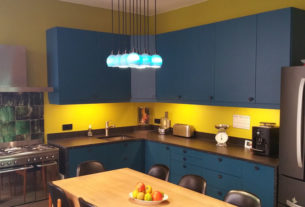By the year 2050, the world population will be 9 billion if the current trend follows. About 70 % of this population will be living in urban regions. Researchers are developing new methods of farming to increase the productivity of the land. Vertical farming in India can be a solution to future food security problems.
Vertical farming is a type of agriculture method in which the crops are grown on vertical levels, stacked upon each other to reduce the space usage for food production. We will look deep into the vertical farming method and things that make it different and more sustainable from conventional farming methods.
How is vertical farming different from traditional farming methods?
Vertical farms are also known as High Rise Farms, as the plants are raised higher above the ground. The thing which makes vertical farming different from other methods is its objective, to provide the optimum environment to the plants for their better growth and development.
The plants are usually grown in a controlled environmental condition, where the parameters such as humidity, temperature, the quantity of macro and micronutrients, all are controlled continuously in a closed space. Farmers always want that their crops will not get damaged due to the external weather conditions. In India, vertical farming can surely fulfil this desire of the farmers.
Why vertical farming is a better choice for growers?
Vertical farming is the modern method of growing crops, having many reasons which make it a better choice for those who believe in the power of innovation and desires to make more profit in the food production sector.
1. All-year-round crop production: A vertical farm has a controlled growing condition by which grower can raise crop even in the off-season. Off-season crop production results in more profit and more availability of food in the market.
Higher Yield: Higher yield is achievable through two ways: By increasing productivity and by increasing the cultivation area. Vertical farming does it both, the plant grows better in a controlled condition, and vertical production extends the crop cultivation area.
Avoidance of droughts and pests: Many regions in our country are prone to drought, and farmers face extensive loss every year. Using the hydroponics or aeroponics crop production technology can save the crop from dying. Vertical farming also reduces water consumption in the food production process, as the plants get irrigated through micro-irrigation technologies such as drip irrigation.
Pests are not a problem in vertical farming because the crops are grown in an enclosed protected area where the probability of pest entry is extremely low.
No need for long-distance transportation: Most of the vegetables and fruits are highly perishable, and long-distance shipping can cause considerable damage to their quality. Vertical farming gives us the freedom to set up the farm near to the market, as the external climate does not influence the crop growth and development in a vertical farm.
What are the challenges in vertical farming?
One of the few challenges of vertical farming in India includes a limited range of crops suitable for this type of agriculture practice, most of them are vegetable and fruit crops. Despite this limitation, growers can grow a variety of crops on their farm to earn high profits. The skilled and experienced workforce is also lacking in this sector.
Another challenge is the high energy consumption, equipment like climate control system, irrigation system, water filtration system and lights consume a large part of the energy. Installing LED grow lights can reduce energy consumption significantly. Technical support at each stage of crop production from government institution is also a challenge for vertical farming in India.
Arable land is decreasing rapidly due to the urbanization process, increasing population, and climate change. Vertical farming seen as the future of food production and rural regions benefited through this type of food production method. Advantages such as all-year-round crop production, better yield and quality are encouraging farming community towards vertical farming.
Fresher and more nutritious food is available the population through vertical farming, this can help them in living a healthier life, especially for those living in urban areas. The central and state government are making farmers aware of the benefits of vertical farming and helping them through different policies and subsidiary schemes.



